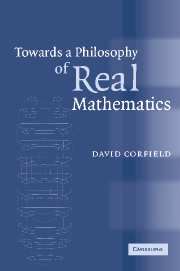PART IV - THE INTERPRETATION OF MATHEMATICS
Published online by Cambridge University Press: 22 September 2009
Summary
Up to this point in the book I have largely been occupied by what is sometimes called descriptive epistemology, the philosophical analysis of the workings of a knowledge-acquiring practice. Philosophy in this vein searches out allusive examples of some discipline's conceptual, social and material apparatus at work. When Nancy Cartwright (1999b) studies the modelling of superconductivity she is not trying to clarify the conceptual presuppositions of this particular branch of physics per se, but rather discerning more general methodological principles. As I have stated already, one should not fall into the trap of demarcating this philosophical activity from some pristine form of normative epistemology. Normative notions may emerge from the description of valued pieces of scientific activity. For Cartwright the development of superconducting quantum interference devices, used in medicine to detect brain damage in stroke victims, is physics being done at its best. This vision leads her to advocate that more resources be devoted to the less glamorous, but more practical, areas of physics (1999a: 16–17).
But developments in a science may serve other philosophical purposes. Besides showing us how physics works, from time to time they change our outlook on fundamental concepts: life, time, causality, matter, the universe. Philosophers of science taking themselves to be the descendants of the Ionian Pre-Socratics have been drawn to the latest scientific developments. Currently, the obvious choice in physics is quantum gravity.
- Type
- Chapter
- Information
- Towards a Philosophy of Real Mathematics , pp. 233 - 236Publisher: Cambridge University PressPrint publication year: 2003



